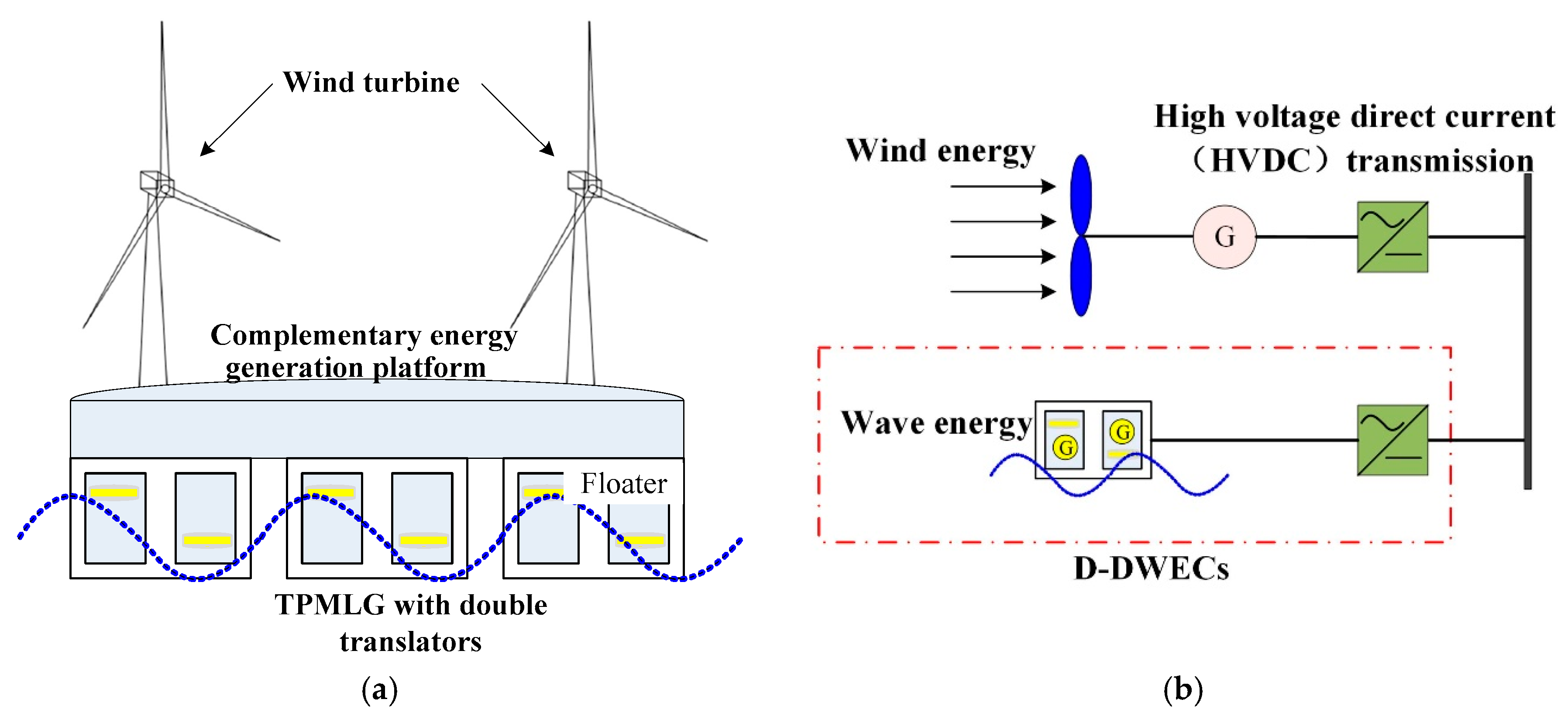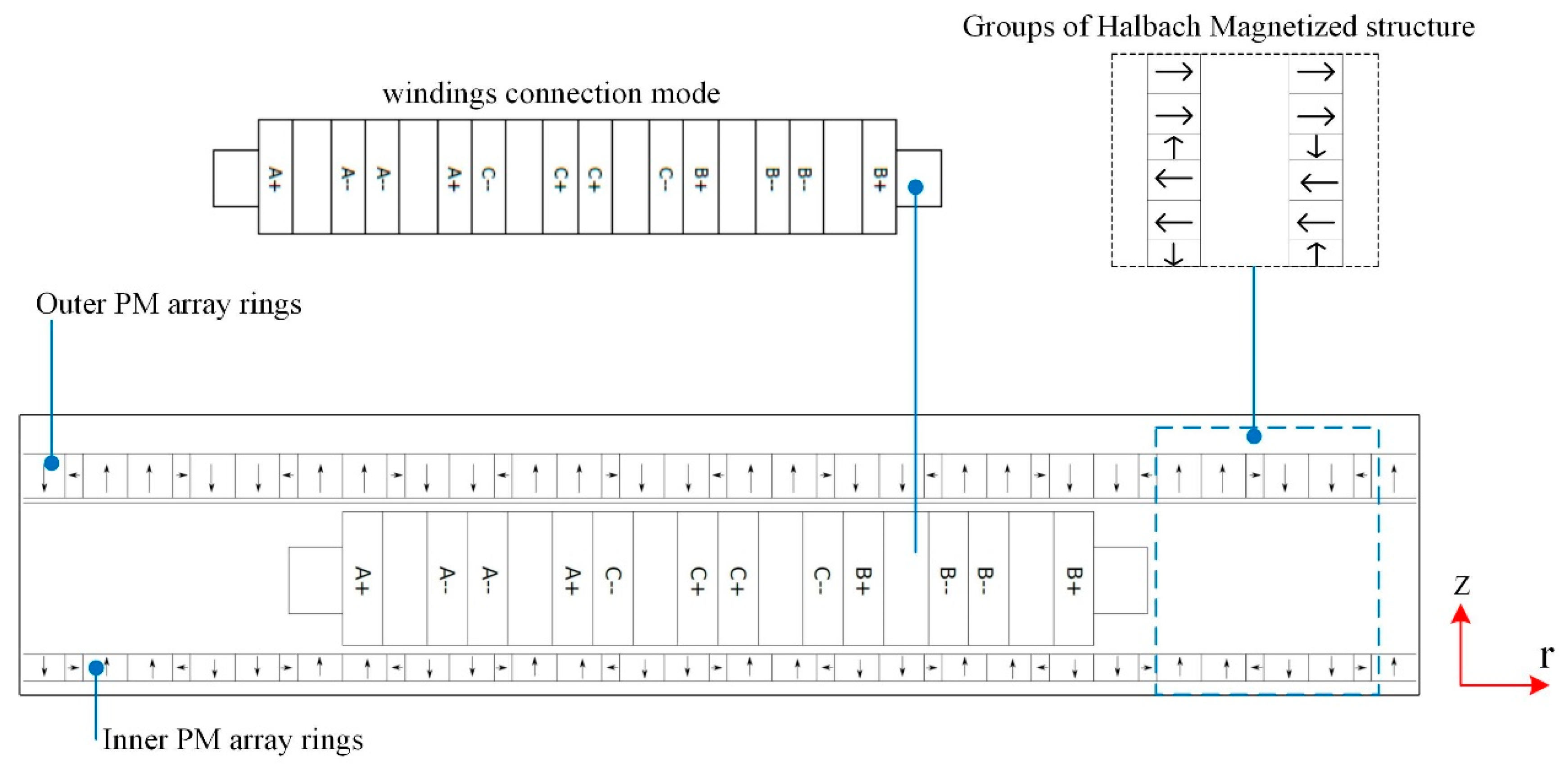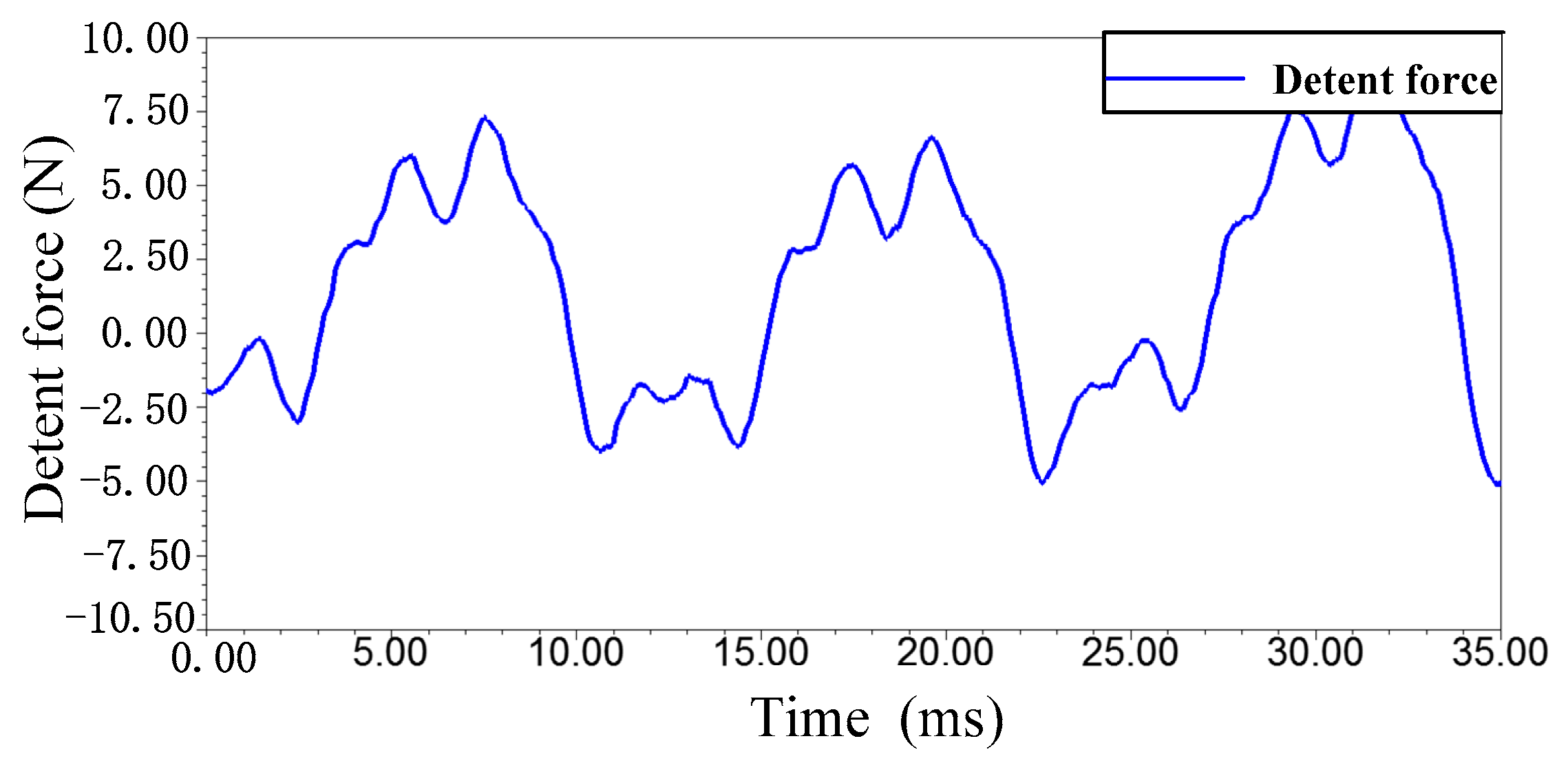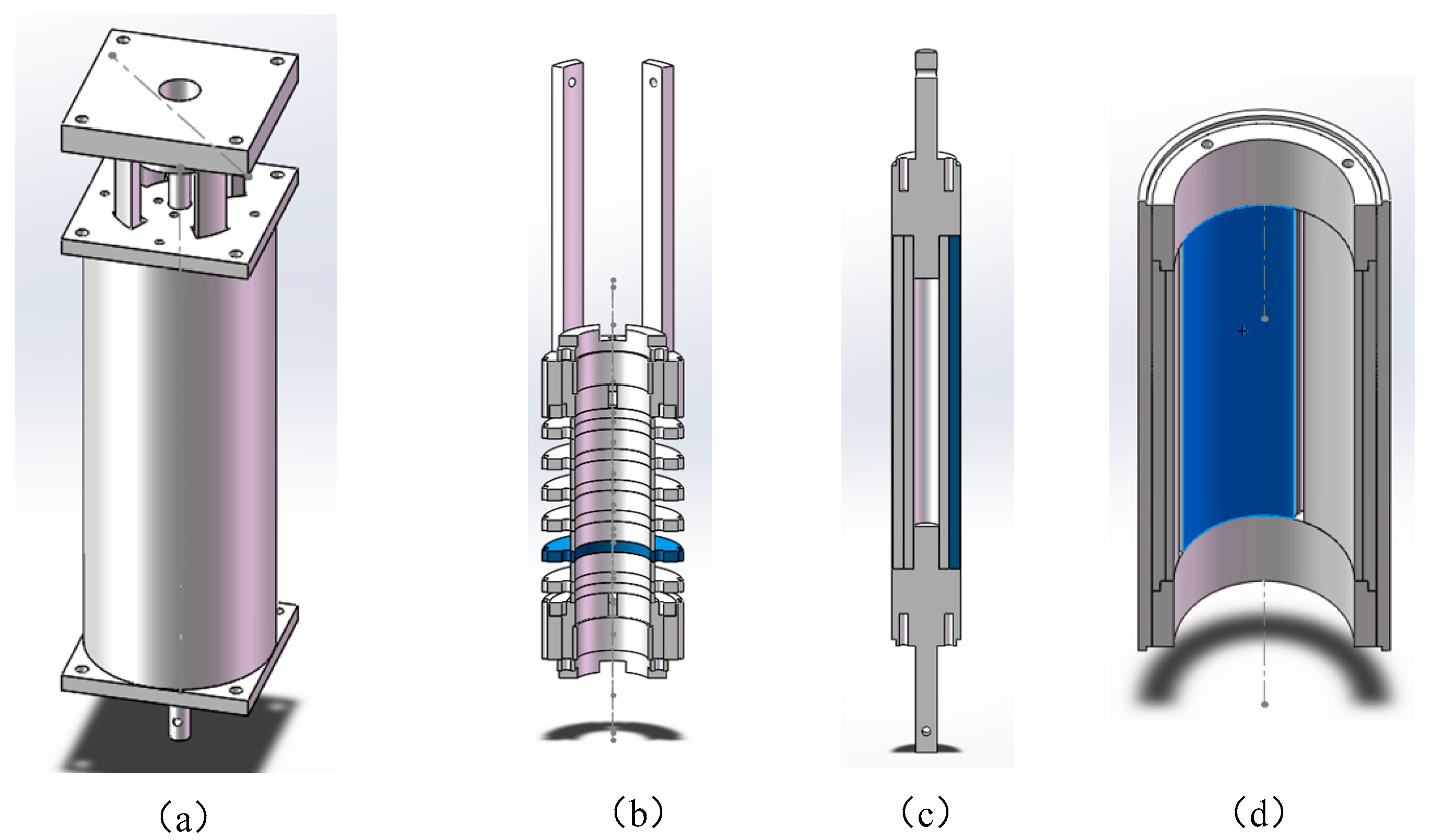Analysis of a PM Linear Generator with Double Translators for Complementary Energy Generation Platform
Abstract
1. Introduction
2. Platform Configuration and Generator Structure
2.1. Platform Configuration
2.2. Generator Configuration
2.3. Groups of Halbach PM Magnetized Structure
3. Generator Magnetic Field Analysis
3.1. Assumptions
- ➢
- The length of the TPMLG in the axial direction is infinite; thus, the magnetic field of the generator can be considered as symmetric along the translator. However, there is a relationship between the edge-end effect and the length of the stator; the edge-end effect is considered in this study.
- ➢
- The slotless structure topology is applied in this TPMLG, and the permeability of translator core and stator core is infinite.
- ➢
- The material NdFeB is used in the TPMLG, the recovery curve almost coincides with the demagnetization curve and the magnet is magnetized uniformly.
- ➢
- For the analysis process is in the matter of no-load, the magnetic field generated by the windings is not considered.
3.2. Magnetic Field Governing Equations
4. Analysis of Performance
4.1. Magnetic Field Distribution
4.2. Analysis of Detent Force
4.3. No-Load Performances
5. Experiment and Comparative Analysis
5.1. Comparative Analysis
5.2. Experiment Analysis
6. Conclusions
- (1)
- The groups of Halbach PM magnetized structure can increase the radial flux density. Magnetic energy density of the TPMLG is increased by optimizing the structure of the two translators.
- (2)
- The groups of Halbach PM magnetized structure can decrease the axial flux density, and the detent force in the TPMLG is reduced. Thus, the stability and conversion efficiency of the systems is obviously improved.
- (3)
- The TPMLG with double translators have the advantages of high flux density, high output efficiency and low detent force fluctuation. Moreover, better performance of the TPMLG is obtained by the D-DWECs in wind and wave complementary energy generation platform.
Author Contributions
Funding
Conflicts of Interest
References
- Melikoglu, M. Current status and future of ocean energy sources: A global review. Ocean Eng. 2018, 148, 563–573. [Google Scholar] [CrossRef]
- Drew, B.; Plummer, A.R.; Sahinkaya, M.N. A review of wave energy converter technology. Proc. Inst. Mech. Eng. Part A J. Power Energy 2009, 223, 887–902. [Google Scholar] [CrossRef]
- Polinder, H.; Mattia, S. Wave energy converters and their impact on power systems. In Proceedings of the International Conference on Future Power Systems, Amsterdam, The Netherlands, 16–18 November 2005; pp. 1–9. [Google Scholar]
- Ozkop, E.; Altas, I.H. Control, power and electrical components in wave energy conversion systems: A review of the technologies. Renew. Sustain. Energy Rev. 2017, 67, 106–115. [Google Scholar] [CrossRef]
- Ahn, K.K.; Truong, D.Q.; Tien, H.H.; Yoon, J., II. An innovative design of wave energy converter. Renew. Energy 2012, 42, 186–194. [Google Scholar] [CrossRef]
- Gao, Y.; Shao, S.; Zou, H.; Tang, M.; Xu, H.; Tian, C. A fully floating system for a wave energy converter with direct-driven linear generator. Energy 2016, 95, 99–109. [Google Scholar] [CrossRef]
- Brekken, T.K.A.; von Jouanne, A.; Han, H.Y. Ocean wave energy overview and research at Oregon State University. In Proceedings of the Power Electronics and Machines in Wind Applications, Lincoln, NE, USA, 24–26 June 2009; IEEE: New York, NY, USA, 2009. [Google Scholar]
- Ekström, R.; Ekergård, B.; Leijon, M. Electrical damping of linear generators for wave energy converters—A review. Renew. Sustain. Energy Rev. 2015, 42, 116–128. [Google Scholar] [CrossRef]
- Polinder, H.; Mecrow, B.C.; Jack, A.G.; Dickinson, P.G.; Mueller, M.A. Conventional and TFPM Linear Generators for Direct-Drive Wave Energy Conversion. IEEE Trans. Energy Convers. 2005, 20, 260–267. [Google Scholar] [CrossRef]
- Prudell, J.; Stoddard, M.; Amon, E.; Brekken, T.K.A.; Jouanne, A. A permanent-Magnet Tubular Linear Generator for Ocean Wave Energy Conversion. IEEE Trans. Ind. Appl. 2010, 46, 2392–2400. [Google Scholar] [CrossRef]
- Mueller, M.A. Electrical generators for direct drive wave energyconverters. IET Gener. Transm. Distrib. 2002, 149, 446–456. [Google Scholar] [CrossRef]
- Leijon, J.; Sjölund, J.; Ekergård, B.; Boström, C.; Eriksson, S.; Temiz, I.; Leijon, M. Study of an Altered Magnetic Circuit of a Permanent Magnet Linear Generator for Wave Power. Energies 2018, 11, 84. [Google Scholar] [CrossRef]
- Shen, Y.; Zhu, Z.Q. Analysis of Electromagnetic Performance of Halbach PM Brushless Machines Having Mixed Grade and Unequal height of Magnets. IEEE Trans. Magn. 2013, 49, 1461–1469. [Google Scholar] [CrossRef]
- Halbach, K. Strong rare-earth cobalt quadrupoles. Bull. Am. Phys. Soc. 1979, 26, 3882–3884. [Google Scholar] [CrossRef]
- Feng, N.; Yu, H.; Hu, M.; Huang, L.; Shi, Z. A Study on a Linear Magnetic-Geared Interior Permanent Magnet Generator for Direct-Drive Wave Energy Conversion. Energies 2016, 9, 487. [Google Scholar] [CrossRef]
- Youn, S.W.; Lee, J.J.; Yoon, H.S.; Koh, C.S. A new cogging-free permanent-magnet linear motor. IEEE Trans. Magn. 2008, 44, 1785–1790. [Google Scholar] [CrossRef]
- Huang, L.; Yu, H.; Hu, M.; Liu, C.; Yuan, B. Research on a Tubular Primary Permanent-Magnet Linear Generator for Wave Energy Conversions. IEEE Trans. Magn. 2013, 49, 1917–1920. [Google Scholar] [CrossRef]
- Zhou, S.; Yu, H.; Hu, M.; Jiang, C.; Hao, L. Reduction of Cogging Force in a Linear Flux-Switching Permanent-Magnet Brushless AC Machine for Direct-Drive Applications. IEEE Trans. Magn. 2011, 47, 3252–3255. [Google Scholar] [CrossRef]















| Symbol | Item | Value |
|---|---|---|
| Hg | Air gap length | 1 mm |
| LS | Stator length | 84 mm |
| LT | Translator length | 156 mm |
| hm | PM thickness | 3 mm |
| τp | PM Pole pitch | 9.6 mm |
| R1 | Back iron thickness | 2 mm |
| R2 | Inner translator radius | 5 mm |
| R3 | Stator radius | 23 mm |
| R5 | Outer translator radius | 28 mm |
| N | Turns of coils | 280 |
| Motor Type | Peak Value of EMF (V) | Peak Value of B (T) | Minimum Value of F (N) | Maximum of η |
|---|---|---|---|---|
| Generator with single translator | 45 | 0.72 | 45 | 77% |
| TPMLG with double translators | 72 | 1.20 | 7.50 | 87.2% |
© 2019 by the authors. Licensee MDPI, Basel, Switzerland. This article is an open access article distributed under the terms and conditions of the Creative Commons Attribution (CC BY) license (http://creativecommons.org/licenses/by/4.0/).
Share and Cite
Zhang, J.; Yu, H.; Shi, Z. Analysis of a PM Linear Generator with Double Translators for Complementary Energy Generation Platform. Energies 2019, 12, 4606. https://doi.org/10.3390/en12244606
Zhang J, Yu H, Shi Z. Analysis of a PM Linear Generator with Double Translators for Complementary Energy Generation Platform. Energies. 2019; 12(24):4606. https://doi.org/10.3390/en12244606
Chicago/Turabian StyleZhang, Jing, Haitao Yu, and Zhenchuan Shi. 2019. "Analysis of a PM Linear Generator with Double Translators for Complementary Energy Generation Platform" Energies 12, no. 24: 4606. https://doi.org/10.3390/en12244606
APA StyleZhang, J., Yu, H., & Shi, Z. (2019). Analysis of a PM Linear Generator with Double Translators for Complementary Energy Generation Platform. Energies, 12(24), 4606. https://doi.org/10.3390/en12244606




